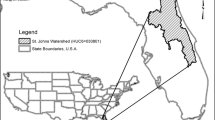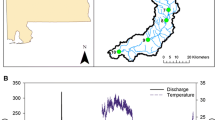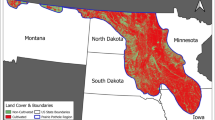Abstract
The potential of wetlands to efficiently remove (i.e., act as a nutrient sink) or to transform nutrients like phosphorus under high nutrient loading has resulted in their consideration as a cost-effective means of treating wastewater on the landscape. Few predictive models exist which can accurately assess P retention capacity. An analysis of the north American data base (NADB) allowed us to develop a mass loading model that can be used to predict P storage and effluent concentrations from wetlands. Phosphorus storage in wetlands is proportional to P loadings but the output total phosphorus (TP) concentrations increase exponentially after a P loading threshold is reached. The threshold P assimilative capacity based on the NADB and a test site in the Everglades is approximately 1 g m−2 yr−1. We hypothesize that once loadings exceed 1 g m−2 yr−1 and short-term mechanisms are saturated, that the mechanisms controlling the uptake and storage of P in wetlands are exceeded and effluent concentrations of TP rise exponentially. We propose a “One Gram Rule” for freshwater wetlands and contend that this loading is near the assimilative capacity of wetlands. Our analysis further suggests that P loadings must be reduced to 1 g m−2 yr−1 or lower within the wetland if maintaining long-term low P output concentrations from the wetlands is the central goal. A carbon based phosphorus retention model developed for peatlands and tested in the Everglades of Florida provided further evidence of the proposed “One Gram Rule” for wetlands. This model is based on data from the Everglades areas impacted by agricultural runoff during the past 30 years. Preliminary estimates indicate that these wetlands store P primarily as humic organic-P, insoluble P, and Ca bound P at 0.44 g m−2 yr−1 on average. Areas loaded with 4.0 g m−2 yr−1 (at water concentrations>150 μg·L−1 TP) stored 0.8 to 0.6 g m−2 yr−1 P, areas loaded with 3.3 g m−2 yr−1 P retained 0.6 to 0.4 g m−2 yr−1 P, and areas receiving 0.6 g m−2 yr−1 P retained 0.3 to 0.2 g m−2 yr−1. The TP water concentrations in the wetland did not drop below 50 μg·L−1 until loadings were below 1 g m2 yr−1 P.
Similar content being viewed by others
References
Chang, S.C. and Stewart, M.L. 1957. Fractionation of soil phosphorus. Soil Science 84: 133–144.
Cooke, J.G., Stub, L. and Mora, N. 1992. Fractionation of phosphorus in the sediment of a wetland after a decade of receiving sewage effluent. J. Environ. Qual. 21: 726–732.
Craft, C.B. and Richardson, C.J. 1993a. Peat accretion and N, P and organic C accumulation in nutrient enriched and unenriched Everglades peatlands. Ecological Applications 3: 446–458.
Craft, C.B. and Richardson, C.J. 1993b. Peat accretion and phosphorus accumulation along a eutrophication gradient in the northern Everglades. Biogeochemistry 22: 133–156.
Davis, J.H. 1943. The natural features of southern Florida. The Florida Geological Survey. Bulletin number 25. Tallahassee, Florida.
Davis, S.M. 1994. Phosphorus inputs and vegetation sensitivity in the Everglades.In: Davis, S.M. and J.C. Ogden (eds). Everglades: the Ecosystem and its Restoration. pp. 357–378. St. Lucie Press, Delray Beach, FL.
Davis, S.M. and Harris, L.A. 1978. Marsh plant production and phosphorus flux in Water Conservation Area 2.In: Drew, M.A. (ed.), Environmental Quality through Wetlands Utilization. Proceedings of the Symposium on Restoration of the Kissimmee River and Taylor Creek-Nubbin Slough Basin, Feb. 28–Mar. 2, 1978. Tallahassee, Florida.
Davis, S.M. and Ogden, J.C. (eds). 1994. Everglades: the Ecosystem and its Restoration. St. Lucie Press, Delray Beach, FL. 826 pp.
Devai, I. and Delaune, R.D. 1995. Evidence for phosphine production and emission from Louisiana and Florida marsh soils. Org. Geochem. 23: 277–279.
Faulkner, S.P. and Richardson, C.J. 1989. Physical and chemical characteristics of freshwater wetland soils.In: Hammer, D.A. (ed), Constructed Wetlands for Wastewater Treatment: Municipal, Industrial and Agricultural. pp. 41–72. Lewis Publishers Inc., Chelsea, Michigan.
Hammer, D.A. (ed). 1989. Constructed Wetlands for Wastewater Treatment: Municipal, Industrial, and Agricultural. Lewis Publishers, Chelsea, Michigan, USA.
Hedley, M.J., Stewart, J.W.S. and Chauhan, B.S. 1982. Changes in inorganic soil phosphorus fractions induced by cultivation practices and by laboratory incubations. Soil Sci. Soc. Am. J. 46: 970–976.
Howard-Williams, C. 1985. Cycling and retention of nitrogen and phosphorus in wetlands: a theoretical and applied perspective. Freshwater Biology 15: 391–431.
Kadlec, R.H. 1985. Aging phenomena in wastewater wetlands.In: Godfrey, P.J., E.R. Kaynor, S. Pelczarski and J. Benforado (eds), Ecological Considerations in Wetlands Treatment of Municipal Wastewaters, pp. 338–350. Van Nostrand Reinhold Company, New York, NY.
Kadlec, R.H. 1994. Phosphorus uptake in Florida marshes. Wat. Sci. Tech. 30: 225–234.
Kadlec, R.H. and Knight, R.L. 1996. Treatment Wetlands Lewis Pub., Boca Raton, FL.
Kadlec, R.H. and Newman, S. 1992. Phosphorus removal in wetland treatment areas: Principles and data report. Everglades Stormwater Treatment Area Design Support. South Florida Water Management District. West Palm Beach, Florida.
Knight, R.L., Rubles, R.W., Kadlec, R.H. and Reed, S.C. 1992. Wetlands for wastewater treatment performance data base.In: Moshiri, G. (ed.), Constructed Wetlands for Wastewater Treatment. pp. 35–58. Lewis Pub. Boca Raton, FL. 632 pp.
Lindsay, A.L. 1979. Chemical Equilibria in Soils. John Wiley and Sons, New York.
Moshiri, G.A. (ed.) 1993. Constructed Wetlands for Water Quality Improvement. Lewis Publ., Boca Raton, FL. 632 pp.
Nicholas, D.S. 1983. Capacity of natural wetlands to remove nutrients from wastewater. J. Water Pollut. Control Fed. 55: 495–505.
Qian, S.S. 1995. A Nonparametric Bayesian Model of Phosphorus Retention in Wetlands. Ph.D. Dissertation, Duke University, Nicholas School of the Environment, Durham, NC, USA.
Qualls, R.G. and Richardson, C.J. 1995. Forms of soil phosphorus along a nutrient enrichment gradient in the northern Everglades. Soil Science 160(3): 183–198.
Reckhow, K.H. and Qian, S.S. 1994. Modeling phosphorus trapping in wetlands using generalized additive models. Water Resources Research 30: 3105–3114.
Richardson, C.J. 1985. Mechanisms controlling phosphorus retention capacity in freshwater wetlands. Science 228: 1424–1427.
Richardson, C.J. 1989. Freshwater wetlands: transformers, filters, or sinks.In: Sharitz, R.R. and J. W. Gibbons (eds), Freshwater Wetlands and Wildlife, 1989, CONF-8603101. DOS Symposium Series No. 61, USDOS Office of Scientific and Technical Information, Oak Ridge, TN.
Richardson, C.J. and Craft, C.B. 1993. Effective phosphorus retention in wetlands — fact or fiction?.In: Moshiri, C.B. (ed.), Constructed Wetlands for Water Quality Improvement. pp. 271–282. Lewis Publishing Inc., Boca Raton, FL.
Richardson, C.J. and J.A. Davis. 1987. Natural and artificial wetland ecosystems: ecological opportunities and limitations.In: Reddy, K.R. and W.H. Smith (eds), Aquatic Plants for Water Treatment and Resource Recovery. pp. 819–854. Magnolia Publishing Inc., Orlando, FL.
Richardson, C.J. and Marshall, P.E. 1986. Processes controlling movement, storage and export of phosphorus in a fen peatland. Ecological Monographs 56: 279–302.
Richardson, C.J. and Vaithiyanathan, P. 1995. P sorption characteristics of the Everglades soils along an eutrophication gradient. Soil Science Society of America 59: 1782–1788.
South Florida Water Management District (SFWMD). 1992. Surface Water Improvement and Management Plan for the Everglades. March 13, 1992. West Palm Beach, FL.
Steward, K.K. and Ornes, W.H. 1975. The autecology of sawgrass in the Florida Everglades. Ecology 56: 162–171.
Swift, D.R. and Nicholas, R.B. 1987. Periphyton and water quality relationships in the Everglades Water Conservation Areas: 1978–1982. South Florida Water Management District, Technical publication no. 87-2, West Palm Beach, Florida.
Toth, L.A. 1987. Effects of hydrologic regimes on lifetime production and nutrient dynamics of sawgrass. South Florida Water Management District, Technical publication no. 87-6, West Palm Beach, Florida.
Toth, L.A. 1988. Effects of hydrologic regimes on lifetime production and nutrient dynamics of cattail. South Florida Water Management District, Technical publication no. 88-6, West Palm Beach, Florida.
Walbridge, M.R. 1991. Phosphorus availability in acid organic soils of the lower North Carolina coastal plain. Ecology 72: 2083–2100.
Walker, W.W., Jr. 1995. Design basis for Everglades stormwater treatment areas. Water Resources Bulletin 31: 671–685.
Author information
Authors and Affiliations
Rights and permissions
About this article
Cite this article
Richardson, C.J., Qian, S., Craft, C.B. et al. Predictive models for phosphorus retention in wetlands. Wetlands Ecol Manage 4, 159–175 (1996). https://doi.org/10.1007/BF01879235
Issue Date:
DOI: https://doi.org/10.1007/BF01879235




